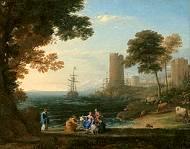 |
 |
 |
 |
Grades/Level: Middle School (6–8)
Subjects: Visual Arts, English–Language Arts
Time Required: 3–5–Part Lesson
One to three class periods
Author: J. Paul Getty Museum Education Staff
Permissions: 
The lesson plan and downloadable materials on this page are licensed under a Creative Commons Attribution 4.0 International License. |
 |
|
 |
 |
 |
 |
 |
 |
 |
Lesson Overview |
 |
Students focus on the Roman mythological story of the abduction of Europa. They compare and contrast how two artists depicted this story. Students are then introduced to the elements of foreshadowing and climax in literature, and how, through the use of color and emphasis, artists use these same elements in painting. Students write responses to the two paintings based on their observations related to foreshadowing and climax. Finally, they read an excerpt from the myth and discuss which part of the story each artist chose to illustrate. |
 |
 |
 |
 |
 |
Learning Objectives |
 |
Students will be able to:
• observe paintings by two different artists that focus on the mythological story of the abduction of Europa.
• compare and contrast how the artists depicted the story.
• examine how the literary elements of foreshadowing and climax are used visually in the two paintings.
• write responses to the two paintings based on their observations.
• examine the literary elements in an excerpt from Ovid's Metamorphoses about the abduction of Europa.
• analyze which part of the story each artist illustrated.
|
 |
 |
 |
 |
 |
 |
 |
 |
 |
Materials |
 |
• Reproduction of Coast View with the Abduction of Europa by Claude Lorrain
• Reproduction of The Abduction of Europa by Rembrandt Harmensz. Van Rijn
• Background Information and Questions for Teaching about Coast View with the Abduction of Europa
• Background Information and Questions for Teaching about The Abduction of Europa
• Student Handout: "Abducting Europa: Compare and Contrast"
• Pens and/or pencils
• Student Handout: "Abducting Europa: Literary and Artistic Devices"
• Paper (8 1/2" x 11"; lined)
|
 |
 |
 |
 |
 |
|
|
 |
 |
 |
 |
 |
Lesson Steps |
 |
1. Show students the reproduction of Coast View with the Abduction of Europa by Claude Lorrain.
2. Have a class discussion, prompting students with the questions from the Background Information and Questions for Teaching about Coast View with the Abduction of Europa.
3. Next, show students the reproduction of The Abduction of Europa by Rembrandt Harmensz. Van Rijn.
4. Have a class discussion, prompting students with the questions from the Background Information and Questions for Teaching about The Abduction of Europa.
5. Tell students that for an activity, they will compare and contrast how the two artists depicted the story of the abduction of Europa.
6. Pass out the handout "Abducting Europa: Compare and Contrast" as well as pens and/or pencils. Guide students to follow the instructions on the handout.
7. Next, discuss with students the elements of foreshadowing and climax in literature, and how, through the use of color and emphasis, artists use these same elements visually in paintings.
8. Tell students that, for their next activity, they will write responses to the two paintings based on their observations related to foreshadowing and climax. Then they will read an excerpt about the myth of the abduction of Europa and discuss which part of the story each artist (Lorrain and Rembrandt) chose to illustrate.
9. Pass out the handout "Abducting Europa: Literary and Artistic Devices" and paper. Guide students to follow the instructions on the handout.
|
 |
 |
 |
| Coast View with the Abduction of Europa, Claude Lorrain, about 1645 |
 |
|
 |
 |
 |
 |
 |
 |
 |
Assessment |
 |
Students will be assessed on their
• comparisons of how the two artists depicted the story.
• written responses to the two paintings based on their observations about how the literary elements of foreshadowing and climax are used visually in the two paintings.
|
 |
 |
 |
 |
 |
Extensions |
 |
Have students discuss this question posed in the "Abducting Europa: Literary and Artistic Devices" student handout: "Was one artist more faithful to Ovid's story?" Depending on their opinions, students may take sides in a lively debate. |
 |
 |
 |
 |
 |
 |
 |
 |
 |
Standards Addressed |
 |
Common Core Standards for English Language Arts
Grades 6–8
READING
Key Ideas and Details
1. Read closely to determine what the text says explicitly and to make logical inferences from it; cite specific textual evidence when writing or speaking to support conclusions drawn from the text.
WRITING
Text Types and Purposes
1. Write arguments to support claims in an analysis of substantive topics or texts, using valid reasoning and relevant and sufficient evidence.
Production and Distribution of Writing
4. Produce clear and coherent writing in which the development, organization, and style are appropriate to task, purpose, and audience.
SPEAKING AND LISTENING
Comprehension and Collaboration
1. Prepare for and participate effectively in a range of conversations and collaborations with diverse partners, building on others' ideas and expressing their own clearly and persuasively.
2. Integrate and evaluate information presented in diverse media and formats, including visually, quantitatively, and orally.
|
 |

|
 |
 |
 |





